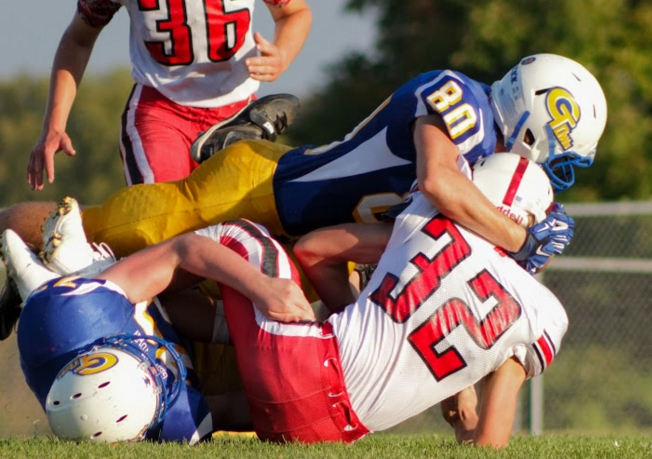Risky but rewarding: The intensity of high school sports continues to rise
February 24, 2016
Seventeen-year old Andre Smith walked onto the football field on Oct. 23 for a game, representing Bogan High School in Illinois. No one expected it to be his last game. Smith suffered blunt force head injuries during the game, and after walking off the field, he collapsed and died. He was the seventh high school football player to die in 2015 nationwide.
Although there have been no events even close to scaling the seriousness of this at Homestead, there has been an increase in the number of injuries related to high school sports. In a survey of 125 Homestead athletes, 107 (85 percent) reported experiencing some sort of injury in playing their sport. The prominent injuries on the rise were concussions and head trauma. According to the Centers for Disease Control and Prevention, emergency room visits increased from 153,375 in 2001 to 248,418 in 2009 among those 19 years old and younger because of traumatic brain injuries sustained in recreational activities. This is a growing problem, as these injuries can create life-long neurological deficits.
A common cause for these injuries is the growing trend of single sport athletes. The expectations for players to be able to make it to college or the pros has contributed to this increase. By focusing on one sport rather than multiple, an athlete can improve their skills year-round and have a better chance to continue play in the future.
Concentrating on one sport results in repetitive motions over and over again which often leads to injury. Mrs. Lindsey Thompson, Homestead athletic trainer said, “Focusing on one thing can lead to overuse injuries, one being Tommy John surgeries in baseball players. When kids play all year round rather than just during the in-season, there are a lot worse injuries.”
Tommy John is the common name for surgeries done on ulnar collateral ligament, or UCL, injuries caused by overuse and are most often in the arms of baseball players. “Kids are over-pitching at a young age. The problem is a lot of baseball programs don’t have pitch counts at a younger age. Kids are pitching hundreds of times a week and their bodies are not meant to be doing that. These injuries happen because they are doing that all year round rather than just in season,” Mrs. Thompson said.
These sports are definitely physically taxing, but can be stressful and emotional as well. Paul R. Stricker, MD, FAAP and youth sports medicine specialist, said, “Adolescents who are struggling for identity among their siblings or classmates may find a unique area of improvement and accomplishment in an activity such as a certain sport, musical instrument, or artistic performance, which causes their self-confidence to blossom. If their identity becomes significantly associated with the sport or activity and if they fail, however, their identity also can fail.”
While the research shows that teen sports have become more intense, the attitude at Homestead is divided. With a three-month season, two-hour practices five times per week seem justified for that short time period. In a survey of 125 student athletes, only 39 (31%) said they would like reduced practices to prevent mental and physical burnout. Mr. Ryan Mangan, athletic director, said, “I think burnout is more of an issue for kids doing multiple sports in the same season or kids who are doing only one sport for a whole year. I don’t see a major issue for in-season only.”
Intense rivals, state goals and a drive to get better are what motivate the student-athletes here at Homestead. With a short season, many would rather improve than take a break. Lauren Grant, junior and volleyball player, said, “Sports are a really good way to refresh your brain. No one comes home right after school and does homework anyways. It’s good to have a two hour break to not be stressed with school work and then you can jump into homework when you get home and your body’s refreshed.”
High school sports are not all about injuries and intense competitiveness. Sports instill hard work and discipline in teens, helping them learn to work as a team and live a healthy life. Dr. Mininder Kocher, an orthopedic surgeon who specializes in adolescent sports medicine at Children’s Hospital Boston, said, “Medically speaking, these kids have lower rates of diabetes, and have heart health. The adolescent athlete is less likely to have drug use, has higher self-esteem and ultimately higher rates of success in life.”
Over the years, there have been higher expectations for high school athletes who hope to play in the future. With this comes an increased intensity of play which has led to more injuries. However, teenage sports are a formative part of teenage life and promote a healthy lifestyle. At Homestead, most student-athletes believe that the benefits of participating in a high school sport outweigh the risks of potential injury. “Injuries are going to happen when you play sports. You’re never truly injury free and that just comes with playing sports. Athletes just need to train differently in the off-season to help prevent overuse,” Mrs. Thompson said.
